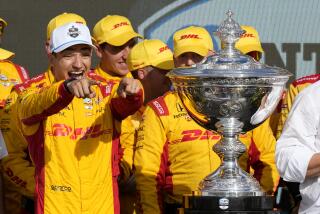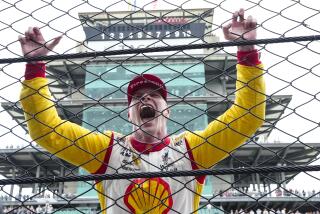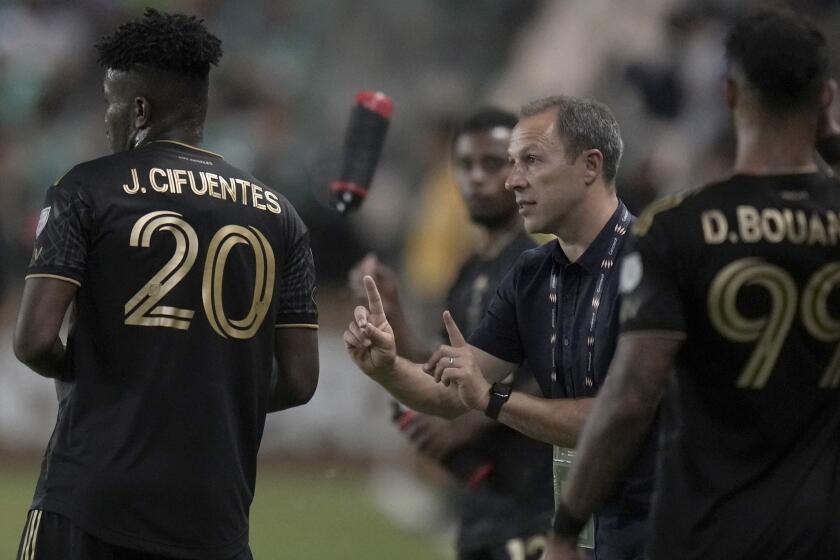Mario Andretti Gets Pole: 215.390 : New Tires, Wind, Drought Blamed as Indy Speeds Drop
- Share via
INDIANAPOLIS — One of the first rules of racing is, “Don’t knock the tires.”
After all, the only contact a racing car has with Mother Earth is on four tiny patches of rubber, and without tires there would be no racing. So no one wants to point the finger at a tire company when problems occur.
One of the first rules of commenting on racing is don’t call a race driver “scared.”
So, apprehension over the performance of radial tires being used for the first time at Indianapolis Motor Speedway, combined with a tricky wind and drought conditions in central Indiana, created the most unusual pole qualifying day since 1955.
Mario Andretti, who predicted speeds of 220 m.p.h. earlier in the week and who ran 218 on several occasions during practice, won the pole for the May 24 race with a surprisingly slow 215.390-m.p.h. average for four laps in his Lola-Ilmor Chevy.
For the first time since 1981, the winning speed did not break the track record.
Two other former 500 winners, defending champion Bobby Rahal and Rick Mears, the track record-holder at 216.828, filled the front row.
Rahal, in a Lola-Cosworth, qualified at 213.316 m.p.h. despite being disturbed by a bouncing beach ball during his run. Mears, who switched to a year-old March late Friday afternoon from his regular Penske PC-16, ran 211.467 with only a minimum of practice laps.
A. J. Foyt, in his 30th consecutive year here, startled himself and his legion of fans with a four-lap average of 210.935, good for the inside of the second row. It was Foyt’s best qualifying spot since 1982.
Foyt spent most of his time during the week tutoring his two proteges, Davy Jones and Stan Fox, and had only a few laps in his Lola.
Even more unusual than the slower than anticipated speeds was the reluctance of drivers to even attempt, or complete, a qualifying run.
Only 11 drivers qualified, several of them accepting less than anticipated speeds late in the day, and left at the gate without qualifying were such veterans as Tom Sneva, Al Unser Jr., Kevin Cogan, Geoff Brabham and Jim Crawford, whose 215.982 was the third fastest time during practice.
It was the smallest number of first-day qualifiers since 1981, when rain helped keep the number to nine. Only two qualified in 1955, when drivers agreed not to run because of dangerous high winds--although, late in the day, Jerry Hoyt, one of the slower drivers, pulled his car to the line and grabbed the pole, with time left for only one other qualifier.
Crawford crashed in the first turn during his second qualifying attempt Saturday, hitting the wall almost head-on after spinning completely around. The impact broke both his ankles and his right shin bone.
The accident was almost a mirror image of incidents during the week in which a number of drivers found the wall.
Sneva, the 1983 winner and former Spokane, Wash., schoolteacher, verbalized the anxiety experienced by the drivers.
“You go into a corner with the car working perfectly,” he said. “The tires are grabbing, and you’re feeling good when suddenly, with no warning, they have no grab at all. All you can do is brace yourself for the wall.”
Al Unser Jr., one of those who elected to come back and try today, warned: “You have to be careful with the tire because (sometimes) it does give up in the middle of the corner.”
Sneva, along with Pancho Carter, Dennis Firestone, Danny Ongais, Dick Ferguson, Rocky Moran, Phil Krueger, Fox, Cogan and Crawford all had solid hits on the cement barriers during the week.
No one would come out and blame the tires, but there is an undercurrent of feeling that something is different, something a lot of drivers aren’t sure how to handle.
“They have new tires, a new feel and a new concept,” said Leo Mehl, worldwide director of racing for Goodyear, the only tire manufacturer involved with Indy car racing. “They’ve been using bias tires here for 50 years, so switching to radials takes some adjustment.
“Some of the teams have adjusted quicker, and they’re the teams running quicker, but everyone is on the bottom of a learning curve regarding radial tires.”
Goodyear made the switch, Mehl said, because the radials’ construction utilizes more modern technology and they have been widely accepted in other racing situations, including Indy car road races and at short tracks such as Phoenix and Milwaukee.
They were used last year in the Pocono 500, but this is the first time they have been at Indianapolis.
“The radial does a number of things better,” Mehl said. “They are more puncture-resistant, they maintain their dimension more accurately during stress, and they wear longer.”
Nearly every team tested the new tires in March and April, and Mehl said there were no complaints.
However, at that time the weather was cool, the track surface was clean and the teams were using 1986 model cars.
“The new ’87 chassis didn’t start arriving until April, so teams were very limited in testing,” Mehl said. “These cars need very precise aerodynamics today, and the cars that were tested in the spring had totally different handling characteristics from the ones that are here.”
The combination of a bright sun--even though temperatures were not high--and the lack of rain created what Andretti called “the worst track conditions I have ever experienced here.”
The sun, beating down on the black line of rubber that had been laid down during the last week, caused the groove to become oily and slippery. Temperatures were much higher a year ago, but rains during the week had cleaned the track. This year, with no rain and two consecutive days of sunshine, conditions deteriorated rapidly.
“When I did my 218 (last Thursday) it was overcast,” Andretti said. “We knew it was a gamble when we went out today, but we felt like we had to take it because we didn’t know if we’d get a second chance or not. The pole was very important to the team. When we went out, our decision was to take any speed faster than Rahal.”
Rahal posted his 213.316 about an hour before Andretti came to the line.
“I had a good lap and a half, and then it was skate city,” Andretti said. “I tried to play with the throttle, but once you do that, the revs (revolutions per minute) come down and you lose speed. I was trying to keep the car going forward, but it seemed like I was going sideways.”
Mario’s son, Michael, was one of the disappointed ones. Michael ran laps of 211 and 209 early in qualifying before crew chief Barry Green called the run off.
It was the fastest speed ever waved off in Speedway history. Hours later, when Michael tried again, the team accepted a 206.129 speed.
“Now when you look back, you wish we had taken the morning times,” young Andretti said. “The problem was that we were oversteering badly. I lost over 2 m.p.h. on the second lap and was having a tough time staying out of the wall. Even with the new tires, it pushed right from the start.”
Danny Sullivan, who got the last spot in the first-day field with a 205.288 lap in a Penske PC-16, isn’t sure it will be good enough to make the May 24 race.
“The crew will be converting my ’86 March-Cosworth to a Chevrolet engine and updating it to ’87 rules,” the 1985 winner said. “We expect the car to be ready Tuesday or Wednesday, and if I get bumped, we’ll go for it in the March.”
Qualifying will resume today and continue next Saturday and Sunday to complete the 33-car starting field.
Winning his third pole of the season gives Mario Andretti a sweep to date. It was also his third Indy 500 pole, the others coming in 1966 and ’67. The span of 20 years is the longest interval between pole wins by a driver in Speedway history.
TENTATIVE INDIANAPOLIS 500 LINEUP
FIRST ROW
No. Driver (Hometown), Car-Engine Speed 5 Mario Andretti (Nazareth, Pa.), Lola-Chevy 215.390 1 Bobby Rahal (Dublin, Ohio), Lola-Cosworth 213.316 8 Rick Mears (Bakersfield), March-Chevy 211.467
SECOND ROW
No. Driver (Hometown), Car-Engine Speed 14 A.J. Foyt (Houston), Lola-Cosworth 210.935 4 Roberto Guerrero (Colombia), March-Cosworth 210.680 22 Dick Simon (San Juan Capistrano), Lola-Cosworth 209.960
THIRD ROW
No. Driver (Hometown), Car-Engine Speed 71 Arie Luyendyk (Netherlands), March-Cosworth 208.337 21 Johnny Rutherford (Fort Worth), March-Cosworth 208.296 18 Michael Andretti (Nazareth, Pa.), March Cosworth 206.129
FOURTH ROW
No. Driver (Hometown), Car-Engine Speed 20 Emerson Fittipaldi (Brazil), March-Cosworth 205.584 4 Danny Sullivan (Louisville), Penske-Chevy 205.288
Average speed: 209.535 m.p.h.
Note: Qualifying continues today and May 16-17.
More to Read
Go beyond the scoreboard
Get the latest on L.A.'s teams in the daily Sports Report newsletter.
You may occasionally receive promotional content from the Los Angeles Times.










